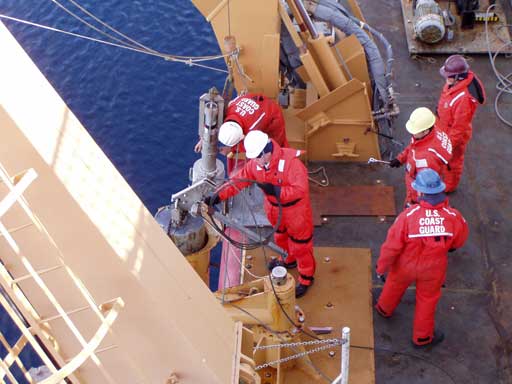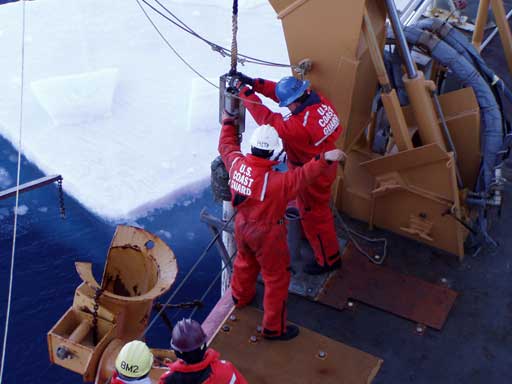( Log In ) Log In is for TREC Teachers & Researchers only
  |
| Steve_Marshall |
 Jun 22 2005, 04:36 AM Jun 22 2005, 04:36 AM
Post
#1
|
 TREC Teacher    Group: TREC Team Posts: 78 Joined: 27-April 05 Member No.: 12 |
Sunday 6/19/05 #2
LET THE CORING BEGIN Continuing our first full day of being freed from the ice, it seems like we are definitely making up for lost time. The plans are to get to the coring site, take a piston core, multicore, plankton tow, ctd profile, and then another piston core. Once again, though, the reality is often different from the plans. The ship was going a little slower than expected, and we were having trouble with the sonar and other acoustic data. The reason the problem with the sonar data is significant, is that this data allows us to see what the subsurface of the seafloor looks like. We canít just put a core anywhere, we need an area of thick sediments, and the only way to recognize this is with a subsurface image that is supplied by the sonar and multibeam data. This was yet another example of how everything and everyone work together to achieve the project objectives. Critical Information  One of the monitors showing the sonar data. Of the two dark profile lines going along the width of the screen, the upper line is the seafloor, the dark line beneath that is the boundary between sediment and harder rock. Looking for areas where the space between these two lines is the thickest and in deep water indicates good spots to core. We lost this information temporarily when approaching our first coring site, so we had a slight delay. This acoustic information was soon restored however. Despite the minor problems, we continued on in the general sample location direction, and when these problems were finally resolved, we managed to get our first core taken. All the other projects planned would have to wait until the next day, but at least we knew they would likely be done. Watching the piston core operation was amazing. I know Iím getting repetitive, but it probably canít be emphasized enough that there is so much coordination that goes into just the piston core alone. The core must be assembled, the ship must be positioned right, ice needs to be kept away from the site, set-up and timing of the deployment, etc are all just some of the things that must be done to make this successful. I will again rely mostly on pictures to describe the process: Getting Ready  Once the ship arrived at the location, coring operations began. Here, the trigger arm, the long metal bar, is fastened to the piston core. The large round object to which the trigger is being attached is the weight that is released when the trigger arm is tripped, and the weight then forces the core into the seafloor. A Coordinated Effort  This shows the crew working on getting the cores ready, while another crew member (background) operates the line that moves the cores to their proper location for release. The Ice Patrol  People are even needed to be ready to keep ice away from the coring area. Here, a long pole is used to move some ice that was getting a little too close Linking the Two Cores  The trigger arm from the piston core (left) is fastened to the gravity core (right). When the gravity core hits the seafloor, it trips the trigger arm which releases the large weight seen at the top of the piston core. This weight is what drives the core into the seafloor. A Good Sign  The gravity core is brought back to the surface. The mud shown at the top of the core indicates it made it all the way beneath the seafloor surface. Arctic Clay  A closer shot of the top of the gravity core. Considering how cohesive the mud and clay seems to be here, itís hard to imagine the core being able to penetrate the sea-floor as far as it did. Secondary Samples  The entire length of the gravity core is shown here. While the main purpose of this core is to trigger the larger piston core, the sediment in this core can still be of value. Back to the Surface  The piston core weight is brought back into the holder. Once secured, a large crane is attached further below the core, and the weight holder rotates as the core is brought up along the side of the ship. Who Are Those Shadowy Characters?  A picture of Greg Cutter and my shadows (Greg is the one to the right with his hand up waving) on the ice as we watch the coring operations from the flight deck. Getting Creative Again  A picture of the piston core taken through the fence netting on the flight deck At this point, I stopped taking pictures because the core bent significantly as it was being brought to the surface. Part of the core was lost, and seeing the cloud of sediment, I thought it was completely lost. It was only later that I learned the researchers and the awesome coast guard technicians on the ship were able to salvage most of it. Missing the pictures of this was okay, though, because we would be doing more coring, and Iíll be taking more pictures. What was another silver lining related to this ďproblem?ĒóSince the part of the core that got bent caused the sediment to be a little too mixed up for ďin placeĒ sampling and dating, I was able to keep this material to be brought back for lab analysis at my school. This series of events reemphasizes another point: Science in the field rarely goes perfectly or exactly as planned, but with dedication, perseverance, and flexibility, useful and valuable results can still be achieved. |
  |
2 User(s) are reading this topic (2 Guests and 0 Anonymous Users)
0 Members:

|
NSF Acknowledgment & Disclaimer | Time is now: 5th November 2024 - 08:28 AM |
Invision Power Board
v2.1.7 © 2024 IPS, Inc.








